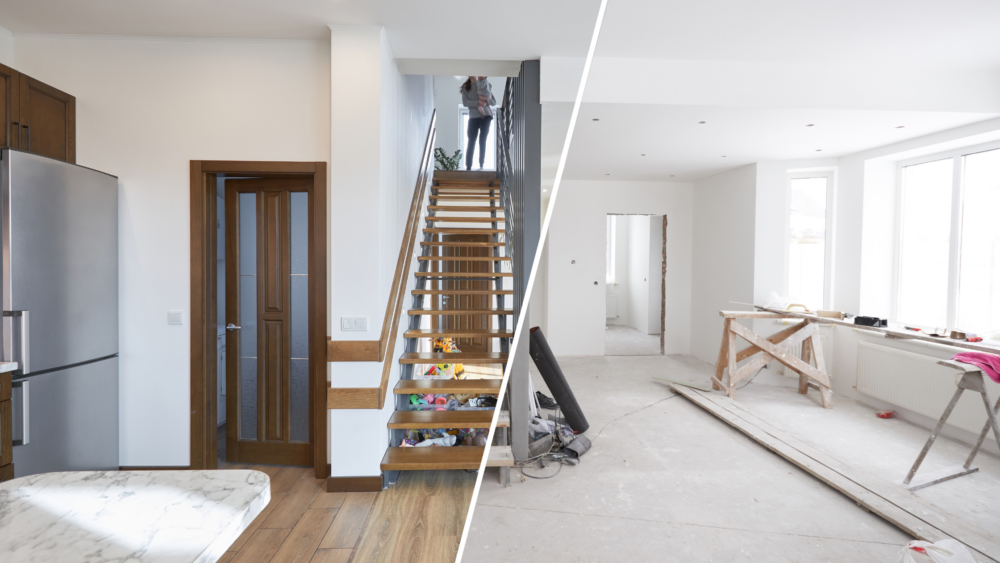Let’s face it, diving into a home renovation can feel like setting sail on turbulent seas. With my sleeves rolled up and sawdust in the air, I’ve seen what to avoid when planning a home renovation project firsthand.
From budgets blowing out of proportion to timelines stretching beyond belief, I’ll steer you clear of the rocky shores where many have run aground. This piece unpacks the nitty-gritty details that will keep your remodel dream from turning into a nightmare – think budget buffers for those just-in-case moments and why skimping on materials might cost you more than dimes down the line.
You’re about to get real-world advice on vetting contractors without getting tangled in empty promises; all so your finished space shines brighter than new penny copper—and holds its value just as well.
Setting the Stage for a Successful Renovation
Embarking on a home renovation project is like setting out on an epic journey—you need to know your destination, path, and resources. It’s not just about picking the right color for your kitchen cabinets or choosing between ceramic tile and hardwood floors; it’s about seeing the big picture.
Recognize the Scope of Your Project
To avoid common renovation mistakes, start planning by assessing every nook and cranny of your space. You’ll want to nail down a solid floor plan that works with—not against—your home’s architectural style. This foresight can prevent headaches down the road when you’re knee-deep in paint swatches wondering why nothing looks quite right.
The scope goes beyond aesthetics though—it’s also making sure there are no surprises hiding behind walls or under floors that could derail progress once work starts. Previous clients often share stories where what seemed like simple remodeling projects morphed into full-blown improvement projects due to unforeseen events—a classic tale in real estate revamps.
Timing Is Everything
Determining project time isn’t just circling a date on your calendar; it’s considering seasons, schedules, and life’s little interruptions. Ever heard someone joke their ‘day project’ turned into six months? That might be because they didn’t build extra wiggle room into their timeline for those all-too-common delays.
Picking an off-season period can save money too—contractors may offer lower bids during slower times of year. So whether you’re overhauling curb appeal or installing smart tech throughout your abode, timing should always play a leading role in any savvy homeowner’s strategy for successful renovations.
Budgeting Wisely for Your Home Makeover
Creating a realistic financial plan is essential to avoid overspending and ensure that you can complete your renovation as expected. If you’ve ever tackled a home makeover, you know the numbers can be as unpredictable as picking the winning lotto ticket.
Adding a Financial Cushion
To combat those sneaky extra costs, savvy renovators add about 20% on top of their budget estimates—it’s like wearing a financial life jacket in case your renovation goes overboard. Think about it: when was the last time any project cost exactly what you thought? Exactly. So when planning out expenses for extra materials, don’t just hope for savings—prepare with purpose.
This percent cushion isn’t pulled from thin air; it’s grounded in reality like concrete foundations. Those unforeseen events will thank you later, whether they’re hiding behind walls or under floors waiting to surprise. And let’s not forget saving money along this journey isn’t just smart—it gives peace of mind faster than sipping chamomile tea.
But why stop at playing defense with your dough? Be proactive by sourcing multiple bids; it’s like speed dating but for finding that dream contractor who won’t leave your wallet weeping. Don’t fall into the trap of choosing the cheapest contractor; instead, opt for value—a smooth operator who combines quality workmanship with fair pricing so both parties win big.
Last tip before we roll up our sleeves: always buy extra… yes, more ceramic tile than needed sounds crazy until one cracks during install and suddenly there’s none left matching yours anywhere on planet Earth. It’s better to have surplus supplies sleeping in storage than being caught short mid-project—that way lies madness (and unplanned trips to hardware stores).
In essence, treat each dollar spent on renovations like an investment toward achieving ‘Home Sweet Renovated Home.’ When done right—with foresight and finesse—you’ll watch every penny pave its way towards making all those house dreams come true.
Selecting Competent Professionals
Finding a good contractor can feel like speed dating with higher stakes. You’re looking for that perfect match who will bring your vision to life without playing the heartbreak hotel tune on your budget.
Vetting Potential Contractors Thoroughly
When you think it’s time to put on the hard hat and get down to business, remember, not all heroes wear capes—some come with hammers and a solid portfolio. Checking a contractor’s references is like swiping right for success; previous clients dish out the real scoop faster than an ice cream parlor in July. Plus, taking a gander at their past work is akin to reading reviews before buying those kitchen cabinets—you wouldn’t buy without knowing what you’re getting into, right? So explore their craftsmanship first-hand.
A good general contractor brings more than just tools—they bring reliability. But let me tell you about this one potential pitfall: falling head over heels for the lowest bid. Sure, saving some green sounds sweet until it turns sour because they cut corners where it matters most—like skimping on extra flooring or using paint that peels off quicker than stickers from a banana.
The Pitfalls of Cutting Corners with Materials
When renovating, it’s tempting to save a buck where you can. But let me tell you, buying cheap materials is like getting a bargain tattoo; it seems like a good idea until it starts fading after the first shower. High-quality windows might seem pricey now, but they’ll keep your home snug and stylish long after those discount panes start leaking air faster than a gossip spills secrets.
Investing in quality over cost savings isn’t just smart—it’s essential for dodging future headaches. Imagine choosing low-grade kitchen cabinets that sag more than an old mattress within months or picking out ceramic tile so fragile that dropping your phone on it turns into an impromptu mosaic project.
Quality Over Cost Savings
Skimping on building materials doesn’t only affect curb appeal; it can lead to higher renovation costs down the road due to repairs and replacements. It’s wise to spend on items used daily because statistics suggest we should recommend high-quality products—like extra flooring—that stand up against wear and tear better than their cheaper counterparts do.
To nail this concept without hitting your thumb instead, think about what lasts longer—a sturdy hardwood floor or flimsy linoleum? Sure, upfront costs may be lower with certain choices but consider how often you’d need touch-ups or full-on do-overs if things go south (which they often do). Trust me when I say green products are not just eco-friendly; they’re also friendly to your future self who’d prefer relaxing weekends over fixing peeling paint—the wrong paint could turn ‘fresh coat’ into ‘total redo.’
Digs Design Company agrees: opting for durability over temporary savings is key in avoiding one of the most common renovation mistakes homeowners make.
Compliance and Safety During Renovations
Neglecting safety during a home makeover is like juggling knives—it’s only a matter of time before something goes wrong. Building codes compliance isn’t just red tape; it’s the blueprint for your family’s well-being.
Avoid Unnecessary Risks
You wouldn’t skydive without checking your parachute, so why start renovation work without securing all necessary permits? It might seem like extra homework but getting these permissions is essential to avoid legal headaches down the road. By staying compliant with local regulations, you’re not just following rules—you’re crafting safe living conditions post-renovation that won’t give potential buyers or inspectors any pause in the future.
Safety oversights can be costly—not just financially but also for peace of mind. Imagine finding out mid-project that your dream kitchen backsplash doesn’t meet fire code standards because you cut corners on materials or hired multiple contractors who weren’t on the same page about building codes. You’ve now got more than eggshells to walk on as this slip could put everything at stake—from timelines and budgets to personal safety.
Meadowlark Builders emphasize that while homeowners may feel eager to see tangible progress in their remodels, ensuring every step aligns with current codes cannot be overstated.
And here’s a stat worth noting: renovations often go beyond initial budget estimates by up to 20%. That includes unforeseen events tied directly back to non-compliance issues—another reason not skimping on prep work pays off later when avoiding costly do-overs due diligence would have prevented.
In short, think of building code adherence as constructing a sturdy fence around your investment—it keeps things within bounds and ensures everyone plays by the rules for a safer tomorrow after all sawdust settles.
Making Informed Design Decisions
When you’re looking to give your home a facelift, smart design choices can mean the difference between a fleeting fad and lasting appeal. Think of your house like an outfit; it should have curb appeal that makes people stop and stare but also timeless designs that stand the test of time.
Balancing Trends with Timelessness
The interior design world is brimming with tempting trends promising to transform your space. But let’s be real: avocado-colored appliances were once all the rage, and we know how that turned out. To avoid cringe-worthy flashbacks, aim for a balance. Mix cutting-edge ideas with classic elements—an architectural style statement piece here or an art deco vase there—to keep things fresh yet enduring.
For example, while picking kitchen cabinets might feel overwhelming amidst endless options, selecting a style complementary to your home’s character will never steer you wrong.
Ensuring Cohesion Throughout Your Home
A hodge-podge of styles under one roof can leave guests feeling they’ve walked through different dimensions in each room—a mid-century modern living room followed by an industrial-chic kitchen? Yikes. So when those renovation gears start turning in your head (and before any work starts), map out a floor plan ensuring cohesive flow throughout every corner of your casa.
Your game plan doesn’t need rigid uniformity—think more “siblings” than “twins.” Aim for harmony among rooms by choosing paint colors or ceramic tile textures that whisper subtle nods to one another across hallways and thresholds. And remember what interior designers say: The devil’s in the details—but so are the angels.
Planning Around Technology Advancements
Tech moves fast, and during a home makeover, it’s like trying to hit a moving target. It can be tempting to pour your budget into the latest gadgets but remember, today’s shiny tech toy is tomorrow’s garage sale bargain.
Smart investments in home technology should not only add convenience now but hold up against the test of time. Instead of spending too much on tech that’ll be obsolete before you’ve figured out how to use it, aim for upgrades that blend seamlessly with your lifestyle and won’t leave you regretting your choices when the next big thing rolls out.
Integrating Thoughtful Tech
Incorporating technology doesn’t mean stuffing every corner with gizmos. Think about what enhances comfort without leading to digital decor overload. When selecting features for your renovation project—whether it’s an intuitive thermostat or built-in speakers—consider longevity over flashiness. Digs Design Co. shows us spaces where tech serves a purpose rather than becoming the focal point; they keep living spaces livable while still savvy.
Surely no one wants their walls littered with outdated screens or cables within months. So think ahead: will this smart kitchen backsplash feel as clever if its apps don’t get updates? Opting for enduring solutions over momentary marvels saves money—and sanity—in the long run.
Making Smart Investments in Home Tech
To really nail down value in technological enhancements, choose options offering adaptability and durability (and maybe skip that fridge with Twitter). Some technologies have proven their staying power—the classics like dimmable lighting systems never go out of style because who doesn’t love setting mood lighting at dinner parties?
Prioritizing Projects by Room Importance
When you’re itching to give your home a facelift, it’s tempting to tear into every room at once. But take it from someone who’s seen too many homeowners bite off more than they can chew: start where it counts most. Kitchens and living rooms are the heart of the house—they deserve your first renovation love.
Start Where It Counts Most
The kitchen isn’t just for cooking; it’s a gathering spot, homework station, and so much more. Revamping this space adds incredible value—both for daily life and future sale potential. Living rooms also pack a punch in terms of curb appeal. They’re what guests see first, setting the tone for their impression of your home.
Here’s why focusing on these areas is smart: working on too many rooms at once spreads resources thin and leads to chaos rather than transformation. Think about that ‘day project’ turning into an unfinished three-month saga because you ran out of tile or funds got tight—definitely not ideal.
Finding Balance in Your Renovation Work
Balancing priorities doesn’t mean other spaces get ignored—it means sequencing projects logically. By knocking out high-traffic areas first, less critical spaces like guest bedrooms can wait without causing daily disruption or diminishing overall progress.
Rome wasn’t built in a day—and neither is the perfect home interior design scheme. Giving yourself permission to focus allows breathing room (or should we say wiggle room?) when those unforeseen events inevitably pop up during renovation work. Meadowlark Builders suggest building extra time into your schedule, precisely because unexpected delays happen all too often.
Managing Expectations Through Effective Communication
Renovating your home is like navigating a ship through the high seas; every member of the crew needs to know their role and destination. This is why not getting everyone on the same page can lead to choppy waters. When you embark on this journey, remember that clear instructions lead to better outcomes.
Keeping all stakeholders informed prevents misunderstandings and aligns everyone’s expectations throughout the renovation process
The secret sauce? It’s communication, pure and simple. By giving detailed specifications upfront, you help contractors grasp your vision with precision. Imagine telling someone about a dream kitchen backsplash but then seeing an entirely different pattern glued onto your walls – not ideal. To avoid such mix-ups, communicate what you want clearly from day one.
Detailed communication isn’t just beneficial; it’s proven essential for success in any collaborative effort – including renovations. A study indicated that keeping stakeholders aligned by providing specific details helps dodge those pesky misunderstandings that could otherwise arise during complex improvement projects.
Clear Instructions Lead to Better Outcomes
Sure as nails are needed for hammering down those new floorboards, crystal-clear instructions ensure results don’t fall short of expectations. For instance, if opting for ceramic tile work or installing custom kitchen cabinets, specificity in design elements means fewer chances of needing last-minute changes which often add cost and delay timelines.
We’re talking more than just aesthetics here—think safety too. Ensuring compliance with local regulations will keep living conditions safe post-renovation—a must according to professionals at Meadowlark Builders. Remember: detailed plans do more than prevent aesthetic blunders—they also safeguard against unnecessary risks.
FAQs in Relation to What to avoid When Planning a Home Renovation Project
What to consider before renovating?
Ponder your goals, budget, and the potential return on investment. Get real about what’s doable.
What three basic factors should be considered before starting a remodeling project?
Weigh design preferences, the current home condition, and financial limits. These shape your remodel’s success.
How can you avoid common and costly home renovation mistakes?
Plan meticulously, choose quality over price cuts for materials, and always vet contractors’ work history.
What not to forget when remodeling a house?
Remember permits; they’re vital. Also think ahead about future tech needs so you don’t lag behind trends.
No Hassle Estimates
We have a nationwide network of the best local contractors ready to quote your project. Get free project quotes at costguide.com.




